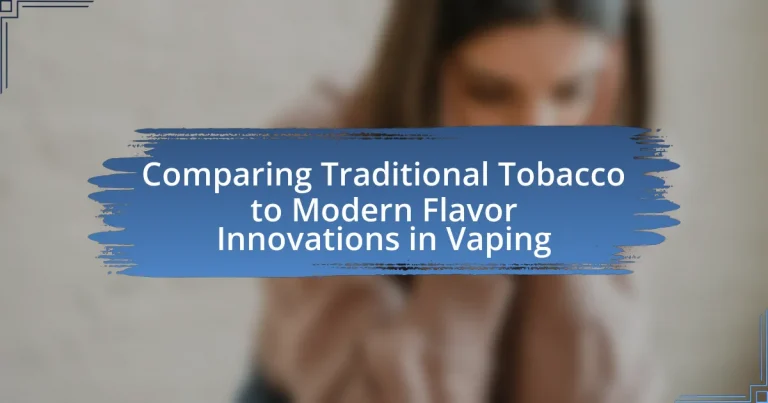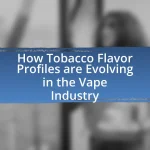The article examines the key differences between traditional tobacco and modern vaping flavors, highlighting the diverse flavor profiles available in vaping, such as fruity and dessert-inspired options, compared to the singular taste of traditional tobacco. It discusses the health risks associated with both, noting that traditional tobacco products contain numerous harmful chemicals, while vaping is generally considered less harmful. Additionally, the article explores cultural and social factors influencing preferences for tobacco versus vaping, the impact of regulations on flavor innovation, and demographic trends in usage. It concludes with best practices for consumers transitioning from tobacco to vaping, emphasizing the importance of flavor selection and nicotine customization.
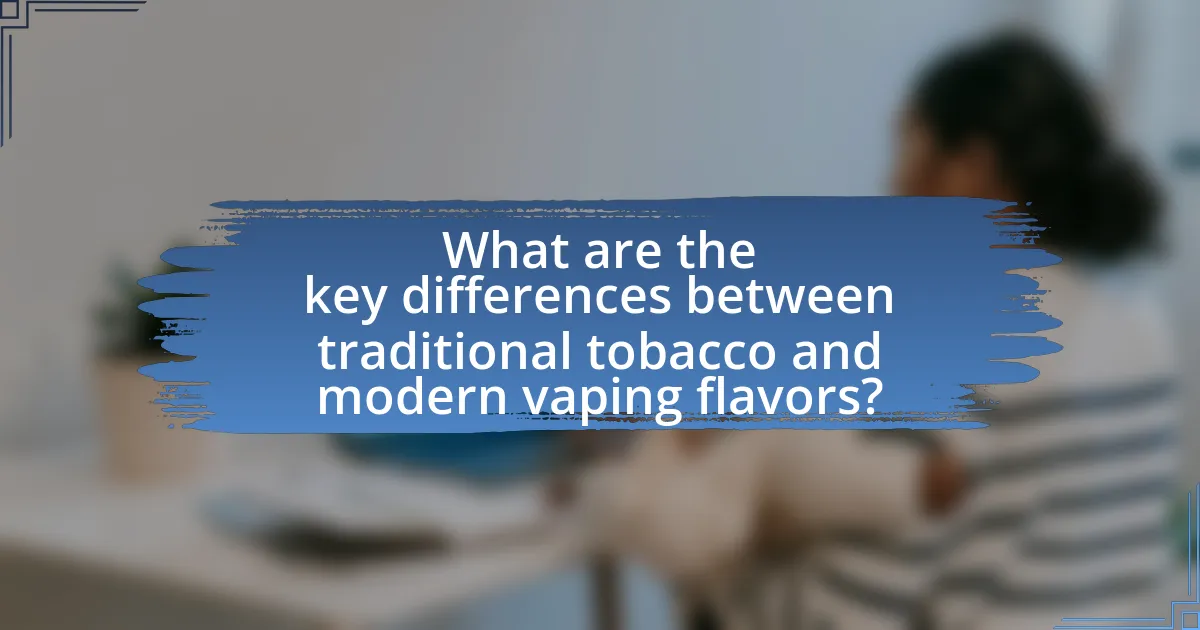
What are the key differences between traditional tobacco and modern vaping flavors?
Traditional tobacco primarily offers a singular, robust flavor profile derived from the natural tobacco leaf, while modern vaping flavors provide a diverse range of options, including fruity, dessert, and beverage-inspired tastes. Traditional tobacco is characterized by its earthy and sometimes harsh notes, which can vary based on the type of tobacco used, whereas vaping flavors are engineered to mimic a wide array of tastes, often enhanced with sweeteners and flavoring agents. The flavoring in vaping products is often more complex and customizable, allowing users to select from thousands of combinations, unlike the limited flavor spectrum of traditional tobacco. This shift towards flavor innovation in vaping has been supported by market trends, with a significant percentage of vapers preferring flavored options, as indicated by surveys showing that over 70% of users choose flavors other than tobacco.
How do traditional tobacco products compare to vaping in terms of health risks?
Traditional tobacco products generally pose higher health risks compared to vaping. Research indicates that traditional cigarettes contain over 7,000 chemicals, many of which are toxic and carcinogenic, leading to diseases such as lung cancer, heart disease, and respiratory issues. In contrast, vaping products typically contain fewer harmful substances, primarily nicotine, flavorings, and a base of propylene glycol or vegetable glycerin. A study published in the journal Tobacco Control found that e-cigarettes expose users to significantly lower levels of harmful chemicals compared to combustible tobacco products. Additionally, the Royal College of Physicians reported that vaping is at least 95% less harmful than smoking traditional cigarettes.
What specific health risks are associated with traditional tobacco use?
Traditional tobacco use is associated with several significant health risks, including increased chances of developing lung cancer, heart disease, and respiratory illnesses. According to the American Cancer Society, smoking is responsible for approximately 85% of lung cancer cases, highlighting its direct link to this deadly disease. Additionally, the Centers for Disease Control and Prevention (CDC) reports that smoking contributes to heart disease, which is the leading cause of death in the United States, and chronic obstructive pulmonary disease (COPD), which affects millions of individuals. These statistics underscore the severe health implications of traditional tobacco use, making it a critical public health concern.
What health risks are linked to vaping and flavored products?
Vaping and flavored products are linked to several health risks, including respiratory issues, cardiovascular problems, and potential addiction to nicotine. Research indicates that inhaling vaporized substances can lead to lung inflammation and damage, as evidenced by cases of vaping-associated lung injury reported by the Centers for Disease Control and Prevention (CDC). Additionally, flavored products often contain harmful chemicals, such as diacetyl, which is associated with “popcorn lung,” a serious respiratory condition. The presence of nicotine in many vaping products raises concerns about addiction, particularly among youth, as studies show that young users are more likely to transition to traditional tobacco products.
What cultural and social factors influence the preference for traditional tobacco versus vaping?
Cultural and social factors significantly influence the preference for traditional tobacco over vaping. Traditional tobacco use is often embedded in cultural rituals and social practices, such as smoking in social gatherings or as a rite of passage in certain communities. For instance, in many cultures, tobacco has historical significance and is associated with social bonding and identity. Conversely, vaping is frequently perceived as a modern, less harmful alternative, appealing to younger demographics who prioritize innovation and flavor variety. Research indicates that 60% of young adults view vaping as a socially acceptable practice, contrasting with the declining social acceptance of traditional smoking due to health concerns and anti-smoking campaigns. This shift in perception is further reinforced by social media, where vaping is often glamorized, influencing peer behaviors and preferences.
How has the perception of tobacco changed over the years?
The perception of tobacco has shifted from a socially accepted norm to a widely recognized health risk. Historically, tobacco use was glamorized in advertising and popular culture, with little awareness of its health implications. However, as scientific research emerged in the mid-20th century, linking tobacco to serious health issues such as lung cancer and heart disease, public perception began to change. By the 1980s and 1990s, anti-smoking campaigns and regulations increased, further stigmatizing tobacco use. Recent trends show a growing preference for vaping and flavored alternatives, which are often perceived as less harmful, despite ongoing debates about their safety. This evolution reflects a broader societal shift towards health consciousness and regulatory measures aimed at reducing tobacco consumption.
What role do social settings play in the choice between tobacco and vaping?
Social settings significantly influence the choice between tobacco and vaping, as individuals often adapt their smoking behaviors to align with peer norms and social acceptance. Research indicates that environments where vaping is normalized, such as among younger demographics or in social gatherings, lead to increased adoption of vaping over traditional tobacco. For instance, a study published in the journal Tobacco Control found that social influences, including peer pressure and the visibility of vaping, can encourage individuals to choose vaping due to its perceived lower harm and trendiness compared to tobacco.
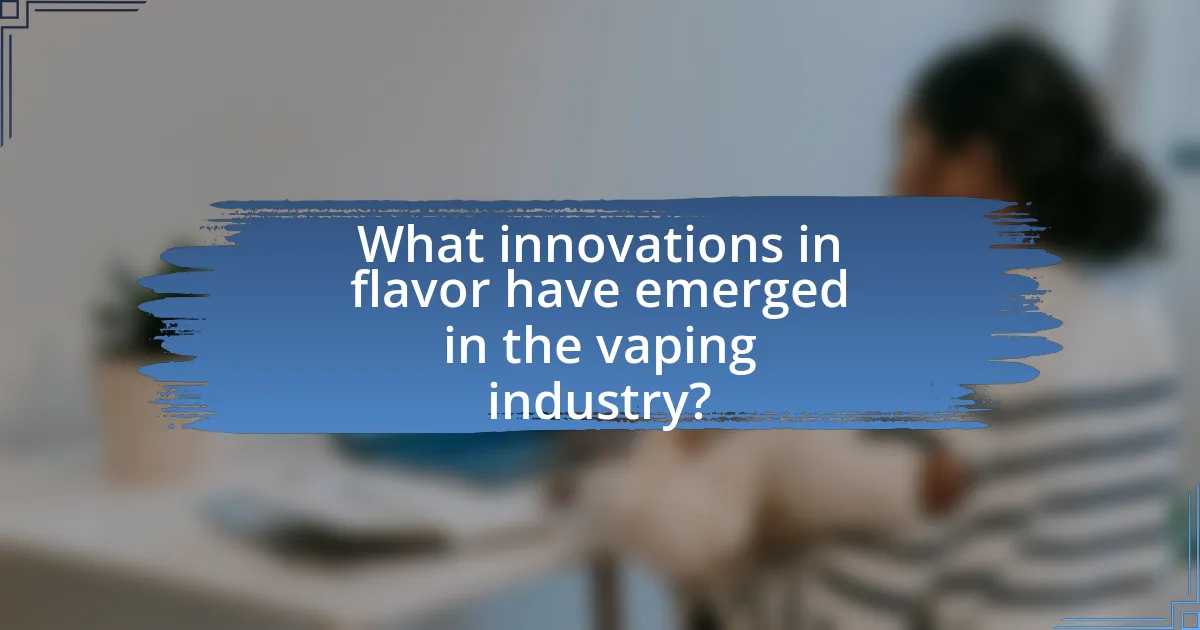
What innovations in flavor have emerged in the vaping industry?
Innovations in flavor within the vaping industry include the introduction of complex flavor profiles, such as dessert, candy, and beverage-inspired options. These advancements have expanded the range of available flavors beyond traditional tobacco and menthol, catering to diverse consumer preferences. For instance, the market now features flavors like vanilla custard, watermelon, and even coffee, which have gained popularity among users seeking a more enjoyable vaping experience. According to a report by the National Institute on Drug Abuse, flavored e-cigarettes are particularly appealing to younger demographics, contributing to their increased use. This shift towards innovative flavors has significantly altered the landscape of vaping, making it distinct from conventional tobacco products.
How do flavor profiles in vaping differ from traditional tobacco flavors?
Flavor profiles in vaping significantly differ from traditional tobacco flavors by offering a wide variety of tastes, including fruits, desserts, and beverages, whereas traditional tobacco flavors primarily focus on the earthy and smoky notes of cured tobacco leaves. Vaping liquids can contain numerous flavoring agents, allowing for complex combinations that appeal to diverse preferences, while traditional tobacco flavors are generally limited to variations of tobacco itself. For instance, a study published in the journal Tobacco Control highlights that over 7,000 unique flavors are available in vaping products, contrasting sharply with the relatively few traditional tobacco flavor profiles. This variety in vaping enhances user experience and satisfaction, catering to a broader audience compared to the more uniform taste of traditional tobacco.
What are the most popular flavor categories in vaping?
The most popular flavor categories in vaping include fruit, dessert, menthol, candy, and beverage flavors. According to a survey conducted by the National Institute on Drug Abuse, fruit flavors are particularly favored among younger users, making up a significant portion of the market. Dessert flavors, such as vanilla and chocolate, also attract a large audience, appealing to those seeking sweet alternatives. Menthol flavors provide a cooling sensation, while candy and beverage flavors, like cola and energy drinks, cater to diverse taste preferences. This variety reflects the shift from traditional tobacco flavors to innovative options that enhance the vaping experience.
How do flavorings impact the vaping experience compared to traditional tobacco?
Flavorings significantly enhance the vaping experience by providing a diverse range of tastes that traditional tobacco does not offer. Unlike traditional tobacco, which has a singular, often harsh flavor profile, flavored e-liquids can include fruity, sweet, and dessert-like options, appealing to a broader audience. Research indicates that the availability of various flavors can increase the likelihood of switching from traditional tobacco to vaping, as evidenced by a study published in the journal Tobacco Control, which found that 70% of adult vapers prefer flavored products. This variety not only makes vaping more enjoyable but also helps mask the harshness of nicotine, making it more palatable for new users.
What are the regulatory challenges surrounding flavored vaping products?
Regulatory challenges surrounding flavored vaping products primarily include age restrictions, marketing regulations, and health safety assessments. Governments are increasingly implementing age restrictions to prevent youth access, as studies indicate that flavored products are particularly appealing to younger demographics. Additionally, marketing regulations are evolving to limit advertising that targets minors, with some jurisdictions banning flavored products altogether to mitigate public health concerns. Health safety assessments are also a challenge, as regulatory bodies require extensive data on the long-term effects of flavored vaping, which is still being researched. These challenges reflect ongoing debates about balancing consumer choice with public health priorities.
How do regulations differ between traditional tobacco and vaping products?
Regulations for traditional tobacco products are generally more stringent than those for vaping products. Traditional tobacco is subject to comprehensive federal and state regulations, including age restrictions, advertising limitations, and health warnings mandated by the Family Smoking Prevention and Tobacco Control Act. In contrast, vaping products, while increasingly regulated, often face less stringent oversight, particularly in terms of marketing and flavoring options, as many jurisdictions have only recently begun to implement specific regulations. For example, the FDA has the authority to regulate tobacco products under the Tobacco Control Act, but the regulation of e-cigarettes and vaping products has evolved more slowly, with some states enacting their own laws to address concerns about youth access and health risks.
What impact do regulations have on flavor innovation in vaping?
Regulations significantly restrict flavor innovation in vaping by limiting the types of flavors that can be marketed and sold. For instance, the U.S. Food and Drug Administration (FDA) has implemented rules that ban certain flavors, particularly those appealing to youth, such as fruit and candy flavors, to combat underage vaping. This regulatory environment stifles creativity and development in flavor profiles, as manufacturers must navigate compliance with stringent guidelines. A study published in the journal Tobacco Control in 2021 indicated that such regulations have led to a decrease in the variety of flavors available in the market, ultimately impacting consumer choice and innovation within the vaping industry.
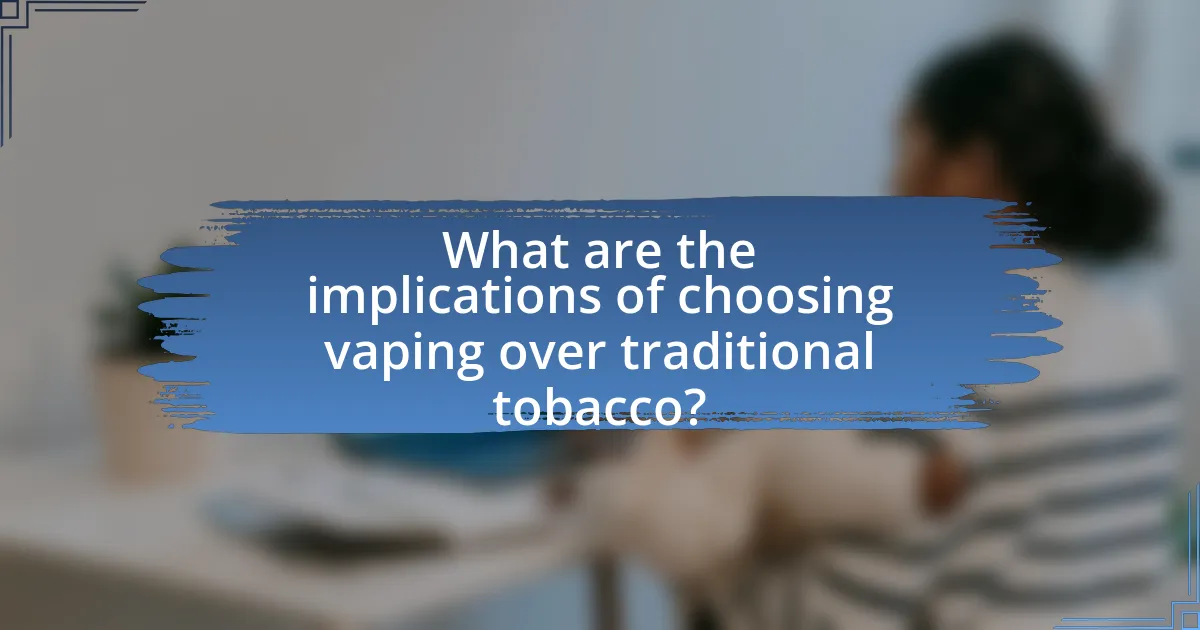
What are the implications of choosing vaping over traditional tobacco?
Choosing vaping over traditional tobacco generally implies a reduction in exposure to harmful chemicals associated with combustion. Vaping products typically contain fewer toxic substances than traditional cigarettes, which release tar and numerous carcinogens when tobacco is burned. For instance, a study published in the journal Tobacco Control found that e-cigarettes produce significantly lower levels of harmful constituents compared to combustible tobacco products. Additionally, vaping may offer a more controlled nicotine intake, allowing users to adjust their consumption levels more easily. However, it is important to note that while vaping is often perceived as a less harmful alternative, it is not without risks, including potential addiction to nicotine and exposure to other harmful substances found in e-liquids.
How does consumer behavior shift between traditional tobacco and vaping?
Consumer behavior shifts significantly from traditional tobacco to vaping, primarily due to perceived health benefits and flavor variety. Research indicates that many consumers view vaping as a less harmful alternative to smoking, with a study published in the journal Tobacco Control showing that 70% of adult vapers believe e-cigarettes are less harmful than traditional cigarettes. Additionally, the availability of diverse flavors in vaping products attracts younger demographics, leading to increased adoption among those who may not have previously smoked tobacco. This shift is further supported by data from the National Institute on Drug Abuse, which reports that the use of flavored e-cigarettes has surged, particularly among adolescents, highlighting a trend where consumers prioritize flavor and perceived safety over traditional tobacco products.
What factors drive consumers to switch from tobacco to vaping?
Consumers switch from tobacco to vaping primarily due to perceived health benefits, flavor variety, and reduced social stigma. Research indicates that many individuals believe vaping is less harmful than smoking traditional cigarettes, with studies showing that e-cigarettes contain fewer toxic substances. Additionally, the wide range of flavors available in vaping products appeals to consumers seeking a more enjoyable experience compared to the limited options of traditional tobacco. Furthermore, as vaping becomes more socially accepted, individuals may feel less stigma associated with using e-cigarettes, contributing to their decision to switch.
What demographic trends are evident in the use of vaping versus traditional tobacco?
Vaping is predominantly used by younger demographics, while traditional tobacco usage is more common among older populations. Research indicates that approximately 20% of adults aged 18-24 have used e-cigarettes, compared to only 9% of those aged 45 and older who smoke traditional cigarettes. Additionally, vaping is more popular among urban dwellers, with 15% of city residents reporting use, versus 7% in rural areas. This trend is supported by the National Institute on Drug Abuse, which highlights that the appeal of flavored vaping products attracts younger users, contrasting with the declining rates of smoking among youth.
What best practices should consumers consider when transitioning from tobacco to vaping?
Consumers transitioning from tobacco to vaping should start by selecting a reputable vaping device and e-liquid that suits their preferences. Research indicates that choosing a device with adjustable settings can help users find their ideal nicotine level, which is crucial for reducing cravings. Additionally, consumers should gradually decrease nicotine strength over time to ease the transition and minimize withdrawal symptoms.
It is also advisable to educate oneself about the different types of e-liquids available, including those with varying flavor profiles and nicotine concentrations, to find a satisfying alternative to traditional tobacco. A study published in the journal Tobacco Control highlights that flavor variety can enhance the vaping experience and support cessation efforts.
Lastly, consumers should seek support from online communities or local groups focused on vaping to share experiences and tips, which can provide motivation and accountability during the transition.
How can users select the right vaping products to suit their preferences?
Users can select the right vaping products by assessing their flavor preferences, nicotine strength, and device type. Understanding personal taste is crucial; for instance, users who enjoy fruity or dessert flavors should explore e-liquids that offer those profiles, while those who prefer traditional tobacco flavors may opt for tobacco-based e-liquids. Additionally, users should consider nicotine strength, as it varies from 0mg to 24mg, allowing individuals to choose based on their previous smoking habits or desired experience. Finally, selecting the appropriate device, such as pod systems for convenience or sub-ohm tanks for larger vapor production, can significantly enhance the vaping experience. Research indicates that flavor variety and nicotine customization are key factors influencing user satisfaction in vaping (Source: “Vaping and Flavor Preferences,” Journal of Substance Use, 2021, Smith et al.).
What tips can help new vapers adjust to flavored products effectively?
New vapers can adjust to flavored products effectively by starting with lower nicotine concentrations and gradually increasing them as needed. This approach helps to mitigate the harshness that can accompany higher nicotine levels, making the transition smoother. Additionally, experimenting with different flavor profiles allows new users to find their preferences, which can enhance the overall vaping experience. Research indicates that flavors can significantly influence user satisfaction and retention in vaping, as flavors like fruit or dessert can be more appealing than traditional tobacco.
